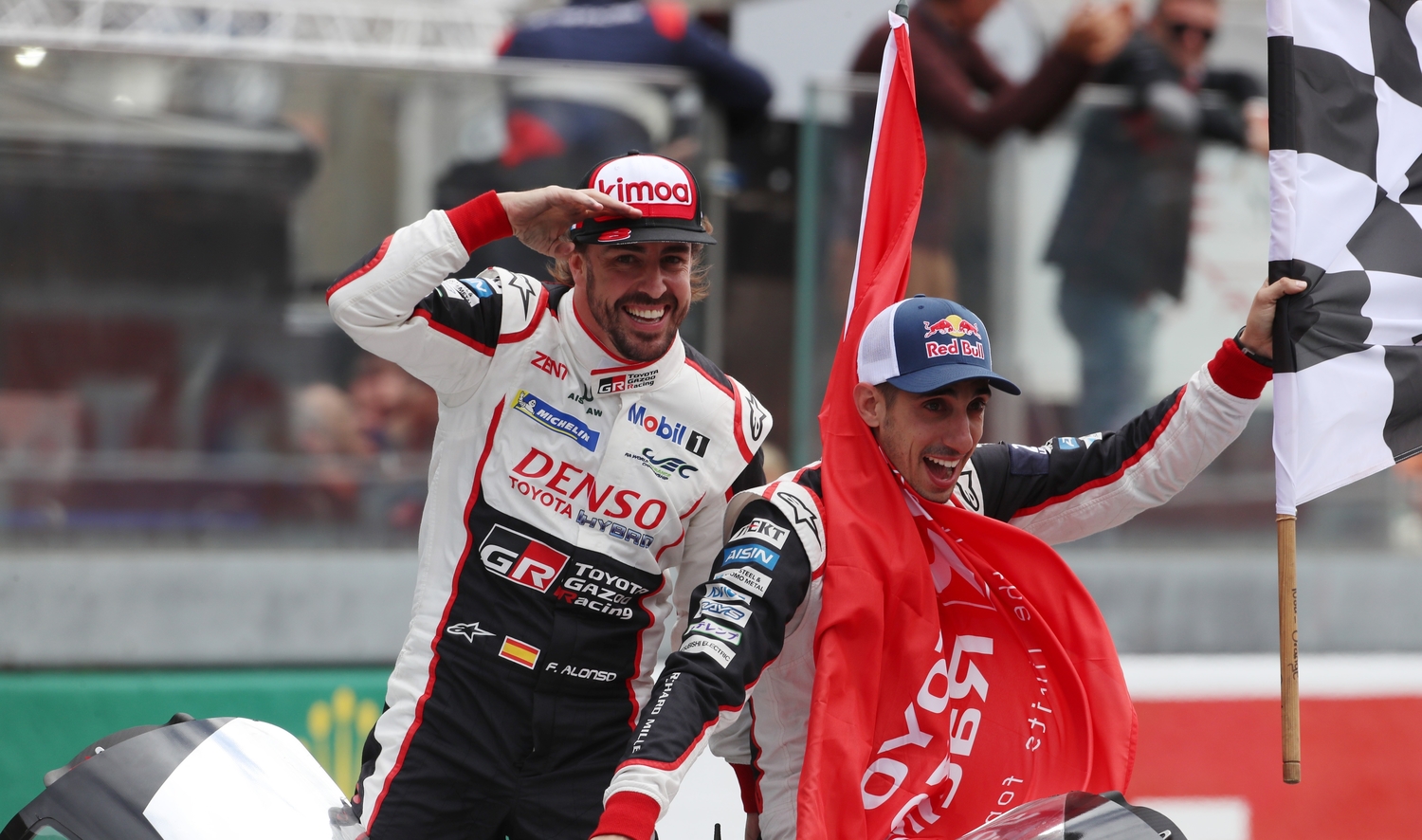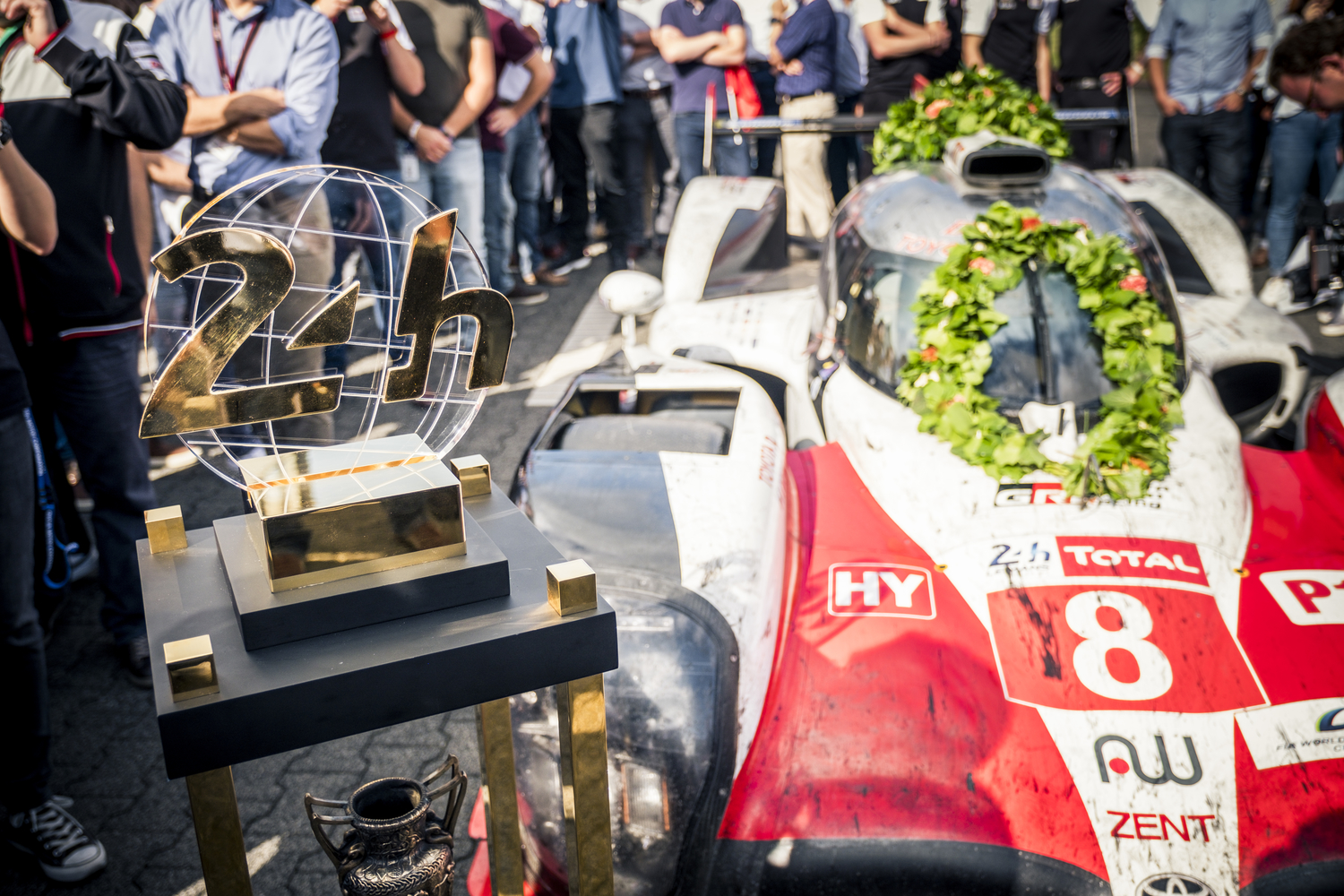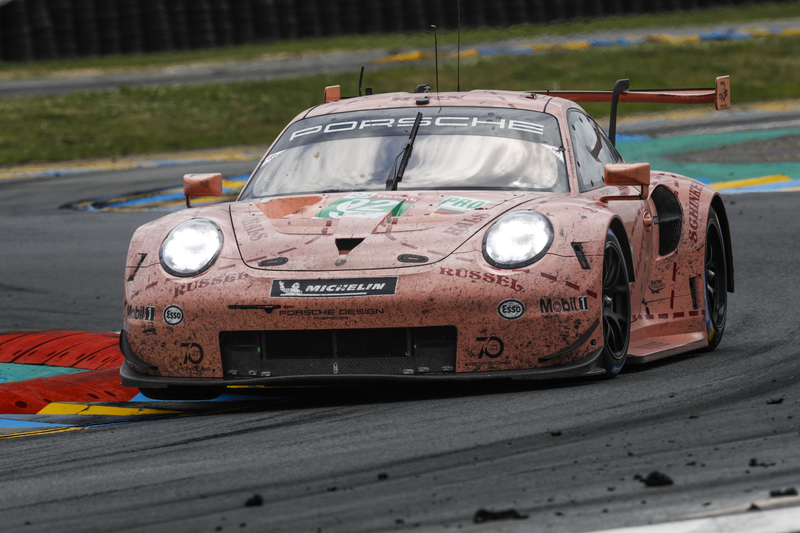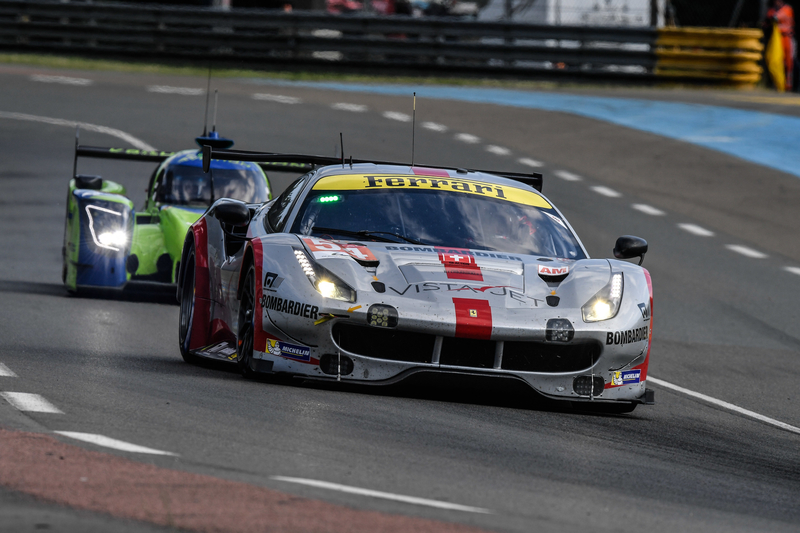
Sportscar Talk: Toyota finally win Le Mans
Over 20 years of blood, sweat and tears was more than worth when the #8 and #7 Toyota LMP1 cars crossed the line after a very tense Le Mans 24 Hours.
The winning team of Sebastien Buemi, Kazuki Nakajima and Fernando Alonso put on a great display and while a lot of the motorsport world will be talking about Alonso and his chances of the Triple Crown (winning the Monaco Grand Prix, Le Mans and the Indy 500) I think Buemi and Nakajima deserve an equal amount of credit.
We must start off with the two-time Formula 1 world champion. Naturally most of the attention was and still is on him. His night stint were he closed down a gap of around 2 minutes and 20 seconds after his teammate, Buemi speeded in a slow zone to collect a one minute stop and go penalty, was brilliant. In my opinion, it was just as good as his performance in last year’s Indy 500. It was probably the best part of the race where Alonso closed down the gap, lap after lap, on the sister car driven by three-time WTCC champion Jose Maria Lopez. He was averaging lap times that were around 3-4 seconds quicker and was lapping in the 3:19s and 3:20s which is really quick. The Spaniard was driving like a man possessed and he must have just been in the zone like the great Ayrton Senna talked about.
You can argue that Lopez is the slowest of the six Toyota drivers and I would have to agree. But lets not forget that Alonso is a rookie to Le Mans and for him to slash the gap down from over two minutes to around 45 seconds after his night stint is superb driving. Considering the lack of miles he has under his belt and the fact that he came into Le Mans from a completely different discipline requiring a different approach and technique he has done extremely well and thoroughly deserved a lot of credit because he was arguably the best Toyota driver over the whole week. Alonso made no mistakes and was very aggressive at the right times. He seemed to struggle a little at the 6 hours of Spa earlier this year when lapping traffic, but was excellent at Le Mans and can adapt so quickly to any car. We heard this on the radio from Alonso, “Tell me if you want another stint. I’ve got into the rhythm of the night!” It certainly made me laugh even though I was struggling to stay awake but it showed how in the zone Alonso was. He said this to Radio Le Mans:
“I felt strong, I felt into the zone, got into it with traffic. It seems when you get lucky with overtakes, you get more lucky with the next ones, and the opposite when you get in unlucky, you get in a loop”
He also commented on how he could drive all night until the next day.
It could so easily have gone the wrong way and Alonso and his teammates could have been lapped. The cynics will say that Toyota put the worst driver in the car to allow the #8 to catch up and it wasn’t helped when Kamui Kobayashi in the #7 put any hope of his car winning to sleep when he didn’t pit when he was meant to and had to do a very slow extra lap at 80KPH all the way around the 13.6KM Circuit de La Sarthe.
I can hear to cynics saying Lopez slowed down in the night and Kobayashi intentionally didn’t come in for fuel or any other excuse just because Alonso was in the winning car. If Alonso wasn’t in the car, none of the conspiracies would be flying around. Yes, Alonso winning is much better for publicity and for Toyota but I genuinely think the #8 was a faster car and the #7 Toyota drivers have said that they struggled in the night phase of the race as they fell out of the operating window with the tyres. It’s not talked about much, but Le Mans does have different tyre compounds and the tyre pressures are very important so perhaps that played a part.

Kazuki Nakajima closed down the rest of the gap and after a 5 hour chase ensuring the #8 Toyota soon retook the lead. Incidentally, Nakajima was the driver that took pole position for the #8 car with a 3min 15.377, six tenths away from last year’s epic pole lap by Kamui Kobayashi. I don’t think either Toyota car maximised their qualifying laps so it’s hard to say if Kobayashi’s amazing lap was beatable. Buemi made the only errors all week long in the #8 car by speeding on two separate occasions in a slow zone. Apart from the slow zone penalties, Kobayashi’s miscommunication or brain fade and Lopez’s spin on Sunday morning, all of the Toyota drivers were on very good form and didn’t get involved with any silly incidents when lapping traffic and the reliability of the car was tremendous.
Coming into the race, the only thing I thought that could stop Toyota was a collision with a lapped car. They had the pace, the reliability, the drivers, the pit crew, the fuel consumption (albeit with a fuel usage limit of 11 laps) and the engineers to make both cars comfortable enough to almost cruise to a Le Mans win. It was by no means easy though. Anybody who wins Le Mans has done a spectacular job and to race for 24 hours is hard mentally and physically. Today’s drivers make it look easy but it really isn’t. Toyota’s quest to win this year’s Le Mans was definitely easier than previous years but you can’t blame them for the sudden decline in manufacturers. I believe that if it wasn’t for some persuasion from the ACO, Toyota could easily have followed Audi and Porsche to leave the WEC, but they haven’t and it’s worth it because they have followed in Mazda’s footsteps to become the second Japanese manufacturer to win Le Mans.
Onto LMP2 and it was announced on Monday that the winners of the LMP2 class had been disqualified after “an additional machined part not featuring in the drawing is inserted into the flow restrictor, changing the wetter restrictor surface described by the regulatory drawing.” (something to do with an illegal device in the pitstop) which was gaining them around 6-8 seconds per fuel stop. Considering that you make over 30 stops in a race, means that the #26 G-Drive car gained at least one lap in the pitstops alone. It’s not the first time the G-Drive Racing team have pushed the limits. They were disqualified from the 2013 Le Mans from 3rd due to too large a fuel tank and a couple years ago in Fuji they intentionally took out a car to help the sister car win the championship. For many, they’re the villains of the WEC.
The #28 TDS Racing entry was also disqualified for the same infringement. I presume that all of the fuel rigs are homologated and checked before the race and it’s very hard to change something to make the fuel flow into the car faster so both entries must have gone some way to effectively cheat. All of this means that the Signatech Alpine Matmut’s #36 Alpine A470 Gibson, driven by Nicolas Lapierre, Andre Negrao and Pierre Thiriet, with the Graff-SO24 #39 Oreca now moving up to second place in LMP2.
The final podium position in class to United Autosports’ #32 Ligier JS P217 Gibson shared by Juan Pablo Montoya, Will Owen and Hugo de Sadeleer which at one point was in the wall at Indianapolis. Both G-Drive Racing and TDS Racing will appeal the result but I cannot see them overturning their disqualifications.

The GTE classes were dominated by Porsche as the “Pink Pig” #92 Porsche, named after the Porsche winning 1971 Le Mans which had a pink livery, dominated the GTE Pro class after a really intense first few hours of the race when there were trains of GTE cars fighting over the same piece of the track on the Circuit de La Sarthe. The best part of the race was in the GTE Pro class when Porsche’s Frederic Makowiecki and Ford’s Sebastien Buemi battled like it was the last race of their lives on Sunday morning. It went on for over a stint and some of the racecraft was as good as it gets. I didn’t like it when Makowiecki swerved numerous times down the Mulsanne Straight. I’ve always been in favour of making one move before the braking zone and sticking with that lane or line. Moving from left to right and right to left repeatedly to try and break the tow is a complete no to me.
I can see why Bourdais got so angry and upset but what a battle it was between the Frenchmen. It was clear that the Porsche had the better top speed though Bourdais was quicker in the corners. When you have the higher top speed, it’s becomes easier to defend and giving you a chance to fight back quickly if you do lose a position, just like Makowiecki demonstrated. Both of their cars finished on the podium with the #91 Porsche in 2nd and the #68 Ford in 3rd.
I am not a fan of BoP (Balance of Performance) at all, and it was quite clear that Porsche had a significant advantage despite the weight added to their car before the race. The ACO always seem to not be able to get it right at Le Mans and I know it’s very hard but we’ve always seen no more than two teams with a really good chance of winning the GTE Pro class each year when it should be all of them because that’s what BoP is for. It’s not even doing it’s job fully at the moment and that must change.

GTE Am was very quiet this year as the #77 Dempsey – Proton Racing team Porsche pretty much led from start to finish. People talk about how Toyota had a perfect race but I think the effort from this car was perfect and the emotion from Patrick Dempsey, even though he’s not driving anymore, was fantastic to see. The #54 Spirit of Race team Ferrari followed in 2nd with the #85 Keating Motorsports team Ferrari rounding out the podium.
It wasn’t the most exciting Le Mans ever but it was still about beating the race. Nearly all of the attention will be on Toyota and Fernando Alonso and it must be said that they will both be back to defend their Le Mans title next year because this WEC season is a “superseason” ensuring we’ll return to Le Mans on 15-16 June for the finale next year. I hope Alonso attempts the Indy 500 as well because if he does, it could be an incredible 4 weeks or so for the Spaniard.
We’ll see about that, but Le Mans delivered a fairytale story once more and this time it was Toyota’s happy ending.



![Private: [ID: 71rYi-xncgM] Youtube Automatic](https://motorradio-xijqc.projectbeta.co.uk/wp-content/uploads/2024/08/private-id-71ryi-xncgm-youtube-a-1-360x203.jpg)
![Private: [ID: 1SfHxvC8Doo] Youtube Automatic](https://motorradio-xijqc.projectbeta.co.uk/wp-content/uploads/2024/07/private-id-1sfhxvc8doo-youtube-a-1.jpg)
![Private: [ID: H6XRkf6kROQ] Youtube Automatic](https://motorradio-xijqc.projectbeta.co.uk/wp-content/uploads/2024/07/private-id-h6xrkf6kroq-youtube-a-1-360x203.jpg)
![Private: [ID: Kb6w-qAmKls] Youtube Automatic](https://motorradio-xijqc.projectbeta.co.uk/wp-content/uploads/2023/12/private-id-kb6w-qamkls-youtube-a-360x203.jpg)
![Private: [ID: CcpwYw20k3k] Youtube Automatic](https://motorradio-xijqc.projectbeta.co.uk/wp-content/uploads/2024/07/private-id-ccpwyw20k3k-youtube-a-360x203.jpg)

![[ID: x1SiRC5jhW4] Youtube Automatic](https://motorradio-xijqc.projectbeta.co.uk/wp-content/uploads/2022/04/id-x1sirc5jhw4-youtube-automatic-360x203.jpg)
![[ID: lMZ8lAeLubk] Youtube Automatic](https://motorradio-xijqc.projectbeta.co.uk/wp-content/uploads/2022/04/id-lmz8laelubk-youtube-automatic-360x203.jpg)
![[ID: GAYCcnqyFo4] Youtube Automatic](https://motorradio-xijqc.projectbeta.co.uk/wp-content/uploads/2022/04/id-gayccnqyfo4-youtube-automatic-360x203.jpg)
![[ID: Gg142H296QY] Youtube Automatic](https://motorradio-xijqc.projectbeta.co.uk/wp-content/uploads/2022/04/id-gg142h296qy-youtube-automatic-360x203.jpg)





